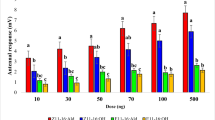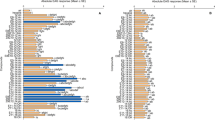Abstract
Electroantennogram (EAG) evaluation of selected compounds from wilted leaves of black poplar, Populus nigra, showed that phenyl acetaldehyde, methyl salicylate, (E)-2-hexenal elicited strong responses from male antennae of Helicoverpa armigera. When mixed with sex pheromone (Ph), some volatiles, e.g. phenyl acetaldehyde, benzyl alcohol, phenylethanol, methylsalicylate, linalool, benzaldehyde, (Z)-3-hexenol, (Z)-3-hexenylacetate, (Z)-6-nonenol, cineole, (E)-2-hexenal, and geraniol elicited stronger responses from male antennae than Ph alone. Wind tunnel bioassay demonstrated that various volatiles could either enhance or inhibit the effect of synthetic sex pheromone. (E)-2-hexenal, (Z)-3-hexenol and linalool in combination with Ph could not induce any male to land on source at all, whereas phenyl acetaldehyde, benzaldehyde, (Z)-6-nonenol and salicylaldehyde combined with Ph enhanced male response rates by 58.63%, 50.33%, 51.85% and 127.78%, respectively, compared to Ph alone. These results suggested that some volatiles should modify sex pheromone caused behavior and that some of them couldpossibly be used as a tool for disrupting mating or for enhancing the effect of synthetic sex pheromone in the field.
Similar content being viewed by others
References
Baker, T.C., Hansson, B.S., Lofstedt, C., Lofqvist, J., 1988. Adaptation of antennal neurons in moths is associated with cessation of pheromone-mediated upwind flight. Proc. Natn. Acad. Sci U.S.A., 85:9826–9830.
Borden, J.H., Chong, L.J., Savoie, A., Wilson, I.M., 1997. Response to green leaf volatiles in two biogeoclimatic zones by striped ambrosia beetle. Trypodendron lineatum. J. Chem. Ecol., 23(11):2479–2491.
Deglow, E.K., Borden, J.H., 1998a. Green leaf volatiles disrupt and enhance response to aggregation pheromones by the ambrosia beetle, Gnathotrichus sulcatus (LeCone) (Coleoptera: Scolytidae). Can. J. For. Res., 28:1697–1705.
Deglow, E.K., Borden, J.H., 1998b. Green leaf volatiles disrupt and enhance response by the ambrosia beetle, Gnathotrichus sulcatus (LeCone) (Coleoptera: Scolytidae) to pheromone-baited traps. J. Entomol. Soc. B. C., 95:9–15.
Dickens, J.C., Smith, J.W., Light, D.M., 1993. Green leaf volatiles enhance sex attractant pheromone of the tobacco budworm, Helithis virescens (Lepi., Noctuide). Chemoecology, 4:175–177.
Ding, H.J., Guo, Y.Y., Wu, C.H., 1997. Olfactory electro-physiological responses of cotton bollworm, to allelochemicals of host plants. Acta Entomol. Sinica, 40(Suppl.):66–72 (in Chinese with English summary).
Dong, S.L., Du, J.W., 2001. Electrophysiological responses of the male antenna to sex pheromone components of Spodoptera exigue Hübner. Cotton Science, 13(4):216–219 (in Chinese with English summary).
Fang, Y.L., Zhang, Z.N., 2002. Influence of host-plant volatiles components on oviposition behavior and sex pheromone attractiveness to Helicoverpa armigera. Acta Entomologica Sinica, 45(1):63–67 (in Chinese with English summary).
Landolt, P.J., Phillips, T.W., 1997. Host plant influences on sex pheromone behavior of phytophagous insects. Annu. Rev. Entomol., 42:371–391.
Li, W.G., Li, Y.P., He, Y.G., 1991. A modified wheat germ diet for rearing five species of cotton lepidopteral insect pests. Contr. Shanghai Inst. Entomol., 10:35–40.
Li, Y.H., 1966. Prediction of occurrence and control of Heliothis armigera with Chinese wing-nut tree bundles in the field. Entomol. Knowledge, 2:67–69 (in Chinese with English summary).
Light, D.M., Flath, R.A., Buttery, R.G., Zalom, F.G., Rice, R.E., Dickens, J.C., Jang, E.B., 1993. Host plant green-leaf volatiles synergize the synthetic sex pheromones of the corn ear-worm and the codling moth (Lepidotera). Chemoecology, 4:145–52.
Lin, F.G., Cheng, Y.M., Wang, F.L., 1998. Application of sex pheromone in the prediction and control of Helicoverpa armigera (Hübner). Entomol. Knowledge, 35(6):347–351 (in Chinese with English summary).
McNair, C., Gries, G., Gries, R., 2000. Cherry bark tortrix, Enarmonia Formosana: Olfactory recognition of and behavioral deterrence by nonhost angio- and gymnosperm volatiles. J. Chem. Ecol., 26(4):809–821.
Meagher, R.L. Jr., Frank, J.H., 1998. Larra bicolor (Hymenoptera: Sphecidae; Larrinae) collected in pheromone- and phenylacetaldehyde-baited traps. Florida-Entomologist, 81(4):555–556.
Ochieng, S.A., Park, K.C., Baker, T.C., 2002. Host plant volatiles synergize responses of sex pheromone-specific olfactory receptor neurons in male Helicoverpa zea. J. Comp Physio. A, 188:325–333.
Reddy, G.V., Guerrero, A., 2000. Behavioral responses of the diamondback moth, Plutella xylostella, to green leaf volatiles of Brassica oleracea subsp. capitata. J. Agric Food Chem, 48(12):6025–6029.
Xiao, C., Gregg, P.C., Hu, W.L., Yang, Z.H., Zhang, Z.N., 2002. Attraction of the cotton bollworm, Helicoverpa armigera (Hübner) (Lepidoptera: Noctidae), to volatiles from wilted leaves of a non-host plant, Pterocarya stenoptera. Appl. Entomol. Zool., 37(1):1–6.
Yuan, G.H., Zheng, Q.W., Ma, J.S., Cao, Z.L., Luo, M.H., Yi, X.M., 1999. Research on spectrum and mechanism of attracting insects with poplar branch. Acta Agriculturae Universitatis Henanensis, 33(2):148–150 (in Chinese with English summary).
Zhang, Q.H., Schlyer, F., Anderson, P., 1999. Green leaf volatiles interrupt pheromone interrupt pheromone response of spruce bark beetle, Ips typographus. J. Chem. Ecol., 25(12):2847–2861.
Zhang, F., Xiangyu, J.G., Geng, W.J., 2000. Relevance of plant volatiles to sex pheromone in luring aphids in the field. Entolologia Sinica, 7(2):178–184.
Zhang, J.T., Meng, X.Z., 2000. Electrophysiologcal responses of Holcecerus insularis Staudinger to the female sex pheromone extracts and standard compounds. Science Silvae Sinicae, 36(5):123–126.
Author information
Authors and Affiliations
Corresponding author
Additional information
Project supported by Knowledge Innovation Program from Chinese Academy of Sciences (CAS) (No. KSCX2-02-5-2) and Shanghai Commission of Science and Technology (Nos. 023912004 and 01JC14051), China
Rights and permissions
About this article
Cite this article
Deng, Jy., Huang, Yp., Wei, Hy. et al. EAG and behavioral responses of Helicoverpa armigera males to volatiles from poplar leaves and their combinations with sex pheromone. J. Zheijang Univ.-Sci. 5, 1577–1582 (2004). https://doi.org/10.1631/jzus.2004.1577
Received:
Accepted:
Published:
Issue Date:
DOI: https://doi.org/10.1631/jzus.2004.1577




